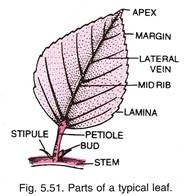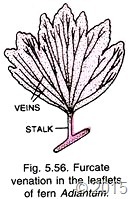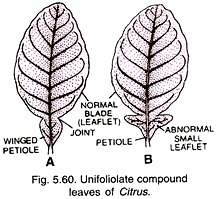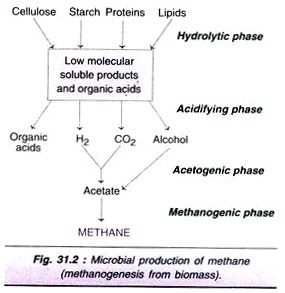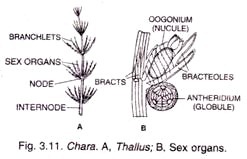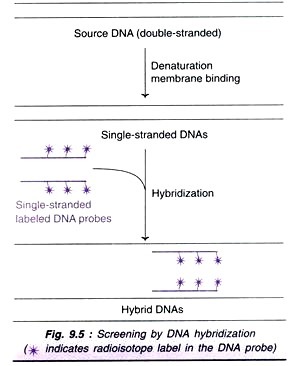In this article we will discuss about:- 1. Definition of Leaf 2. Characteristics of Leaf 3. Parts 4. Types 5. Modification 6. Functions 7. Importance.
Contents
Definition of Leaf:
Leaf is a green, dissimilar exogenous lateral flattened outgrowth which is borne on the node of a stem or its branch and is specialised to perform photosynthesis. Typically it is a thin expanded green structure which bears a bud in its axil.
The green colour of the leaf is due to the presence of chlorophyll. Leaves are arranged in acropetal order. They develop as lateral outgrowth from shoot apical meristem. They are important vegetative organs which are specialised for photosynthesis. All the green leaves of a plant are collectively called foliage.
Characteristics of Leaf:
(i) It is dissimilar lateral flattened outgrowth of the stem,
(ii) The leaf is exogenous in origin,
(iii) It is borne on the stem in the region of a node,
(iv) An axillary bud is often present in the axil of the leaf,
(v) Leaf has limited growth,
(vi) An apical bud or a regular growing point is absent,
(vii) The leaf base may possess two lateral outgrowths called stipules,
(viii) A leaf is differentiated into three parts— leaf base, petiole and lamina,
(ix) The lamina possesses prominent vascular strands called veins,
(x) It is green and specialised to perform photosynthesis,
(xi) Leaf bears abundant stomata for exchange of gases,
(xii) It is the major seat of transpiration.
Parts of a Leaf:
A leaf consists of three parts— leaf base, petiole and lamina. Lamina (= epipodium) or leaf blade is the terminal thin, expanded, green and conspicuous part of the leaf which is specialized to perform photosynthesis. The flattened lamina or leaf blade is supported by veins and veinlet’s which contain vascular tissues for conduction of water, mineral salts and prepared food.
There are two surfaces— adaxial (ventral, upper) towards the upper part of stem and abaxial (dorsal, lower) towards the lower part of stem. The two surfaces are quite distinct in dorsiventral leaves (most dicot leaves) but are quite similar in isobilateral leaves (most monocot leaves).
Petiole (= mesopodium) is a cylindrical or sub-cylindrical smooth or grooved stalk of the leaf which lifts the lamina above the level of stem so as to provide it with maximum exposure. Leaf having petiole is called petiolate. It is termed sessile if the petiole is absent.
Leaf base (= hypo podium) is the lowermost part of the leaf by which the leaf is joined to the node of the stem. It protects the young axillary bud. Leaf base is often indistinguishable from the petiole.
In many legumes it is swollen. The swollen leaf base is known as pulvinus. It is responsible for sleep and shock movements of certain leaves, e.g., Mimosa pudica. Leaf base may be broadened to enclose the stem. It is called sheathing leaf base.
The latter is of two types— amplexicaul (enclosing stem completely as in Grasses, Wheat) and semiamplexicaul (enclosing the stem partially, e.g., Buttercup).
Leaf base often contains two small lateral outgrowths called stipules. A leaf with stipules is called stipulate while the one without stipules is termed as exstipulate. In grasses an outgrowth is present between leaf base and lamina. It is called ligule. The leaf with ligule is called ligulate.
I. Stipules:
They are two small lateral outgrowths of the leaf base which protect the young leaf and its axillary bud in the young state. In some compound leaves, the leaflets bear basal lateral outgrowths named stipels, e.g., Bean, Clitoria, Vicia.
Different types of stipules are:
(i) Free Lateral:
Small, free, green outgrowths, e.g., Shoe-flower (Hibiscus rosa-sinensis),
(ii) Scaly Very small dry membranous stipules, e.g., Cassia fistula,
(iii) Axillary or Intrapetiolar:
Stipules are fused from their inner margins to become axillary, e.g., Gardenia,
(iv) Opposite:
Stipules are fused from their outer margins to become opposite the leaf, e.g., Castor,
(v) Interpetiolar:
Adjacent stipules of opposite leaves are fused to appear in between the petioles, e.g., Anthocephalus (Kadam), Ixora.
(vi) Adnate or Petiolar:
Stipules fused with petiole, e.g., Rose, Groundnut,
(vii) Ochreate:
Stipules fuse to form a sheath or ochrea around the stem, e.g., Rumex, Polygonum,
(viii) Bud Scales:
Stipules of young leaves connate to protect bud, e.g., Ficus,
(ix) Foliaceous:
Large and green, e.g., Pisum.
(x) Stipular Spines (Fig. 5.52 A, B):
Stipules are transformed into spines, e.g., Acacia, Zizyphus. The two stipular spines of Zizyphus are unequal with one straight and second bonked
(xi) Stipular Tendrils:
Stipules are modified into tendrils, e.g., Smilax (Fig. 5.52 C) for climbing.
It is the arrangement of leaves on the stem or its branches (Gk. phyllon— leaf, taxis— arrangement). The purpose or function of phyllotaxy is to arrange leaves in such a way that all of them get proper exposure to sunlight.
Phyllotaxy is of the following three types (Fig. 5.53):
1 .Spiral:
Only one leaf is borne on a node and the leaves of the adjacent nodes roughly lie towards the opposite sides (e.g., Shoe Flower). The simplest type of such a phyllotaxy is alternate or spiral distichous in which the leaves of a branch form two alternate rows (e.g., Grass).
In others, leaves form 3, 4, 5 or several rows called orthostichies. The condition is called tristichous, tetrastichous, pentastichous, etc. In such cases phyllotaxy is determined by passing a thread along the bases of successively higher leaves till a leaf comes to lie exactly above the first one (which is counted as zero).
The spiral made by the thread is called genetic spiral. Phyllotaxy is written by taking the number of circles as numerator and the number of leaves as denominator, e.g., 1/3, 2/5, 3/8, 5/13, 8/21.
These phyllotaxic series are also called Schimper-Brown series in which each member of the series is the sum total of numerators and denominators of the two previous ones. Angle between two successive leaves or angular divergence is calculated by multiplying the phyllotaxy with 360, e.g., 1/3 x 360 = 120.
2. Opposite:
Two leaves are borne on the opposite sides of a single node.
Opposite phyllotaxy is of two types:
(a) Opposite and Superposed:
Leaves of the successive nodes lie in the same plane so that only two rows are formed on the stem, e.g., Quisqualis (Rangoon Creeper), Syzygium (=Eugenia, lambolana, vem, jamun).
(b) Opposite and Decussate:
The opposite leaves of the adjacent nodes lie at right angles so that four rows of leaves are formed on the stem, e.g., Calotropis (vern Ak), Sacred Basil (vern. Tulsi), Zinnia, Guava.
3. Whorled or Verticillate:
Three (e.g., Nerium or Oleander, vern. Kaner) or more than three (e.g., Alstonia) leaves develop from a single node. The leaves of one whorl generally alternate with those of the adjacent whorls in order to provide for maximum exposure. Cyclic phyllotaxy includes both opposite and whorled types of phyllotaxy.
II. Venation:
The arrangement of veins and veinlet’s on the lamina of a leaf is called venation. Veins and veinlet’s are skeletal as well as conducting prominences visible on the surface of lamina, especially the under surface in dorsiventral leaves.
Their important functions are:
(i) Conduction of water through xylem.
(ii) Providing channels for translocation of organic nutrients,
(iii) Conduction of minerals,
(iv) By their large number, the veins and veinlet’s provide skeletal support to the lamina so that it can remain stretched for its optimum functioning,
(v) Veins and veinlet’s reduce the effect of wilting. Venation is of three main types— reticulate, parallel and furcate.
1. Reticulate Venation (Fig. 5.54):
The veinlet’s form a reticulum or network. Reticulate venation is found in dicots (exceptions; Calophyllum, Corymbium, Eryngium).
It has two sub-types:
(i) Pinnate or Unicostate Reticulate Venation:
The lamina has a single principal vein or midrib which extends from its base to apex. It gives rise to lateral veins along its entire length Tike the plumes of a feather. Veins bear veinlet’s. The veinlet’s form reticulations, e.g., Peepal (Ficus religiosa), Shoe-Flower (Hibiscus rosa-sinensis).
(ii) Palmate or Multicostate Reticulate Venation:
A number of prominent or principal veins arise from the tip of the petiole and reach either the apex or margins of the lamina. They give rise to lateral veins connected by reticulations of veinlets.
Multicostate venation is of two forms;
(a) Convergent:
The principal veins converge towards the apex of the lamina, e.g., Zizyphus, Smilax.
(b) Divergent:
The principal veins diverge towards the margins, e.g., Castor (Ricinus), Luffa, Vitis (Grape Vine), etc.
2. Parallel Venation (Fig. 5.55):
Veinlet’s are inconspicuous. Reticulations are absent. The veins run parallel to one another. Parallel venation is characteristic of monocots with the exception of a few (e.g., Smilax, Colocasia, Alocasia, Dioscorea).
Parallel venation is of two subtypes:
(i) Pinnate or Unicostate Parallel Venation:
There is single principal vein or midrib that runs from base to the apex of the lamina. The lateral veins run parallel to one another without forming anastomoses, e.g., Banana (Musa paradisiaca), Canna.
(ii) Palmate or Multicostate Parallel Venation:
Several parallel principal veins arise from the base of the lamina.
Depending upon their orientation there are two forms:
(a) Convergent:
The principal veins converge towards the apex, e.g., Bamboo, Grass,
(b) Divergent:
The principal veins proceed towards the margins, e.g., Fan Palm (Livistonia).
3. Furcate Venation (Fig. 5.56):
The veins branch dichotomously. The finer branches do not form a reticulum. It is common in ferns (e.g., Adiantum). Among higher plants furcate venation is found in Circeaster.
III. Pinnate Leaf:
The plan of venation is similar to that of a feather. The simple leaf is unicostate, that is, it has a single principal vein or midrib. When Compound, the leaf bears leaflets on an elongated axis derived from midrib and called rachis.
IV. Palmate Leaf:
The plan of venation is similar to a hand. When simple, leaf is multicoatate, that is, it has a number of principal veins, In compound leaf, leaflets are borne jointly on the tip of the petiole.
V. Simple Leaf:
A leaf having a single or undivided lamina is called simple leaf. The lamina can have various types of incions, which may reach upto half (-fid), more than half (-partite) or near the base of midrib (-sect). Depending upon the pinnate or palmate venation, the incisions are known as pinnatifid, palmatifid, pinnatipartite, palmatipartite, pinnatisect and palmatisect (Fig. 5.57).
VI. Compound Leaf:
A compound leaf is that where the lamina is completely broken up into distinct segments or leaflets which are separately articulated at the base. The leaflets resemble leaf in having base, stalk and blade. The leaflets (pinnae or pinnules) differ from the whole leaves in the absence of axillary buds, basal stipules and origin in the same plane.
The compound leaves are of two types:
1. Pinnate Compound Leaves:
Here the leaflets are borne laterally on an elongated axis. The axis may represent the midrib or lateral vein of a simple leaf.
The various kinds of pinnate compound leaves are as follows (Fig. 5.58):
(i) Unipinnate:
The leaf is divided only once in a pinnate fashion. The leaflets or pinnae are attached on an axis which is a continuation of the petiole. It is called rachis. The leaflets are commonly borne in opposite or sub-opposite (e.g., Murraya) pairs.
The unipinnate leaves are of two types:
(a) Paripinnate:
The leaflets of this unipinnate leaf are even in number (Fig .5.58A), e.g., cassia fistula (vern. Amaltas), sesbania, Tamarind (vern.Imli).
(b) Imparipinnate:
The leaflets are odd in number with a terminal unpaired leaflet (Fig. 5.58 B), e.g., Rose, Murraya, Neem (Azadirachta indica).
(ii) Bipinnate:
Here the pinnate leaf is divided twice pinnately (Fig. 5.58 C). The leaflets called pinnules, are borne on the secondary axes known as rachillae or rachules. The rachillae are arranged in a pinnate fashion on the Primary axis or rachis, e.g., Acacianilotica (vern. Kikar), Mimosa pudica (Sensitive Plant), Albizzia (Sirin, Siris).
(iii) Trip-innate:
The leaf is thrice pinnate. The leaflets or pinnules are borne on tertiary axes (Fig. 5.58 D), e.g., Moringa (vern. Sahinjana, Soanjana), Meha azedarac (vern. Dharek, Drek).
(iv) Decompound:
In this type the leaf is more than thrice pinnate (Fig. 5. 58 E), e g Fennel Coriander (vern. Dhania), Carrot (vern. Gaajar). In several such cases the development of lamina is suppressed and the compound branches of the rachis remain green carrying on the function of photosynthesis.
2. Palmate Compound Leaves:
The palmate compound leaf is one in which the petiole bears leaflets at the tip like the fingers of the palm. A joint may be present between the tip of the petiole and the leaflets.
Depending upon the number of the leaflets present, a palmate compound leaf is called:
(i) Multifoliolate or digitate (five or more leaflets, present at the tip of petiole, Fig. 5.59 F), e.g., Bombax (Red Silk Cotton, vern. Simbal), Cleome;
(ii) Quadnfoliolate or quadrinate (four leaflets attached to tip of petiole, Fig. 5.59 D), e.g., Paris quadrifolia; Marsilea also seems to have quadrifoliolate leaves (Fig. 5.59 E), although in reality its leaves are pinnately divided;
(iii) Trifoliolate or ternate (three leaflets, Fig 5 59 В, C), e.g., Aegle marmelos (Wood Apple, vern. Bael), Butea (Dhak), Oxalis;
(iv) Bifoliolate or binate (two leaflets, attached side by side at the tip of petiole, Fig. 5.59 A), e.g., Balanites, Hardwickia;
(v) Unifoliolate (a single leaflet separated from the petiole by a constriction) e.g., Citrus (Fig. 5.60).
The leaf of a citrus (Fig. 5.60) appears to be a simple leaf with an undivided lamina and winged petiole. However, it has a joint or constriction between the lamina and the petiole of the leaf. The close relatives of Citrus possess trifoliolate leaves (Aegle marmelos, Fig. 5.59 C).
Even in Citrus many abnormal leaves bear two small leaflets just on the sides of the normal blade (Fig. 5.60 B). This clearly shows that the leaf of Citrus is, in reality, a palmate compound leaf where the two lateral leaflets have been suppressed and only the central leaflet (the normal blade) is functional. Such a palmate compound leaf, with one functional leaflet, is called unifoliolate compound leaf.
Different Types of Leaf:
Anatomically there can be three types of leaves— dorsiventral (bifacial), isobilateral (equifacial) and unifacial.
1. Dorsiventral (Bifacial):
The leaves are commonly horizontal in orientation with distinct upper and lower surfaces. The upper surface is also called inner, adaxial or ventral surface. The lower surface is correspondingly called outer, abaxial or dorsal surface. Mesophyll is distinguishable into palisade and spongy tissues with palisade usually restricted to the upper side. Most of the dicotyledonous leaves are dorsiventral.
2. Isobilateral (Equifacial):
The leaf is placed in such a way that both its surfaces receive equal amount of sunlight. A distinction into upper and lower surfaces is absent. Mesophyll is usually indistinguishable (or palisade tissue is present in equal amount on both the sides). Most of the monocotyledonous leaves are isobilateral.
3. Unifacial:
A distinction into upper and lower surfaces is absent. The leaves are generally cylindrical, e.g., Onion.
Dorsiventral Mesophytic Leaf:
The upper or adaxial surface which faces the sun is darker than the lower or abaxial surface.
The different parts are (Fig. 6.35):
1. Upper or Adaxial Epidermis:
It consists of a single layer of tightly packed rectangular-barrel shaped transparent parenchymatous cells which are devoid of chloroplasts. The inner and the radial walls of the epidermal cells are thin. The outer walls are cutinised.
A distinct layer of cuticle lies on the outside of the epidermis. The cuticle prevents excessive transpiration, helps bind epidermal cells and protects them from mechanical injury. Hair may occur here and there. They are also covered over by a layer of cuticle. Mesophytic leaves may have stomata in the upper epidermis.
2. Lower or Abaxial Epidermis:
It bounds the leaf on the lower surface. The abaxial epidermis consists of a single layer of compactly arranged rectangular transparent parenchymatous cells. Their outer or lower walls are cutinised. A distinct layer of cuticle is also present. The cuticle is, however, less developed than at the adaxial epidermis. Hair may occur here and there. They are usually multicellular and are covered by a layer of cuticle.
The abaxial epidermis contains a large number of pores called stomata or stomates. They lead internally into sub-stomatal cavities or chambers. Sub-stomatal cavities are connected with intercellular spaces of mesophyll. Each stoma or stomate has a narrow pore bounded and controlled by two small specialised kidney-shaped epidermal cells called guard cells.
Their stomatal walls are thicker than the rest. Unlike other epidermal cells, the guard cells possess a few chloroplasts. The opened stomata allow the gaseous exchange between the interior of the leaf and the atmosphere.
Incidentally this also causes transpiration. In many plants the two guard cells are associated with two or more specialized epidermal cells called accessory or subsidiary cells. Depending upon the distribution of stomata on the leaf surface, leaf is called hypostomatic (stomata only on lower surface) and amphistomatic (stomata on both surfaces).
The various functions of the epidermis are:
(i) Protection of internal tissues
(ii) Exchange of gases through stomates
(iii) Loss of water vapours or transpiration through stomata
(iv) Reducing the rate of surface transpiration by the presence of cuticle
(v) Reducing the rate of transpiration by forming a stationary layer of air with the help of hair
(vi) Protection from microbial attack due to presence of cuticle.
3. Mesophyll (Gk. meson— middle, phyllon— leaf):
The interior of the leaf, between the upper and the lower epidermis, contains veins and a parenchymatous green tissue or chlorenchyma. The chlorenchyma of leaf is known as mesophyll. Mesophyll is usually differentiated into two regions, upper palisade and lower spongy.
The palisade parenchyma or palisade mesophyll lies below the upper epidermis. It consists of 1-3 layers of vertically elongated, parallel and closely placed columnar or cylindrical cells. The long axes of these parenchyma cells lie at right angles to the surface of the leaf.
The palisade mesophyll cells enclose a number of narrow intercellular spaces for exchange of gases. The compactness of palisade tissue is directly dependent upon the light intensity to which the leaf is exposed. The palisade parenchyma or palisade mesophyll cells are rich in discoid chloroplasts. They are, therefore, the main seat of photosynthesis.
The spongy parenchyma or spongy mesophyll lies between the lower epidermis and the palisade parenchyma. Its cells may have various outlines like oval, rounded, irregular, lobed or branched. They have chloroplasts but fewer than present in the palisade parenchyma.
The cell walls are thin but are suberised and un-wettable in many species. The spongy cells are very loosely arranged except around the vascular bundles. They enclose large cavities or intercellular spaces which are connected with the atmosphere through the stomata. For this a large sub-stomatal cavity lies below each stoma.
As the chloroplasts are more abundant in the compact palisade mesophyll cells than the loosely arranged spongy mesophyll cells, the upper surface of the leaf appears deeper green as compared to the lower surface.
4. Vascular System or Strand:
It is made up of a number of vascular bundles of varying sizes depending upon the venation. The vascular bundles of ribs are thicker than those of lateral veins. The vascular bundles are generally found at the boundary between the palisade and the spongy regions.
Each vascular bundle is surrounded by a sheath of compactly arranged parenchyma cells called bundle sheath. The bundle sheath of the larger veins show parenchymatous extensions towards both the upper and lower sides.
The vascular bundles are almost rounded. They are conjoint and collateral, i.e., they possess both phloem and xylem which lie on the same radius. Xylem lies towards the upper side of the leaf while phloem is found towards the lower surface. Xylem consists of vessels, tracheids, xylem parenchyma and a few xylem fibres.
The vessels and tracheids conduct water and mineral salts besides providing mechanical support to the leaf. Xylem parenchyma stores food and allows lateral movement of water and mineral salts. Xylem fibres, when present, give additional strength to the leaf.
Phloem is made up of sieve tubes, companion cells and phloem parenchyma. Phloem fibres are rarely present. Sieve tubes conduct organic food. Phloem parenchyma cells store food and help in the lateral conduction of food. Companion cells are supposed to control the function of sieve tubes.
On the outer side of the vascular tissues of a bundle may be found a few layers of sclerenchyma fibres. They are, however, more abundant on the upper region just above the xylem. They provide rigidity and mechanical strength to the leaf.
5. Midrib:
Mesophyll is absent in the region of midrib and other larger veins. Collenchyma or sclerenchyma occurs towards the two epidermal layers for providing mechanical strength. The centre contains a number of vascular bundles which are embedded in a parenchymatous ground tissue.
Isobilateral Leaf (Typical Monocot Leaf, Fig. 6.36):
The isobilateral monocot leaves usually do not show a distinction into petiole and lamina. The leaf base is commonly sheathing, that is, covering the stem partially or completely. The venation is parallel. Both the surfaces can face the sun.
Therefore, the two surfaces are equally green (Gk. iso— equal, bi— two, lateris— side). The internal structure also does not show much differentiation of upper and lower sides.
The various parts of a typical isobilateral leaf (e.g., Maize) are as follows:
1. Epidermis:
A uniseriate or single-layered epidermis occurs on the two sides of the leaf. The epidermis consists of compactly arranged oval rectangular transparent parenchymatous cells. The cells are thickened on the free side where silica and cutin are deposited. A distinct layer of cuticle occurs on the outside.
At places the upper or adaxial epidermis contains groups of larger thin-walled protruding and turgid cells over the region of veins. They are called bulliform or motor cells. The cells are highly vacuolate and can store water, if available.
However, in case of water deficiency the bulliform cells lose water and become flaccid. As a result the leaf gets rolled up to reduce the exposed surface. The bulliform cells are also useful in the unrolling of leaf during its development.
Both the surfaces contain stomata. The leaf is, therefore, amphistomatic. Each stoma or stomate is lined by a pair of dumb bell-shaped guard cells. Unlike other epidermal cells, guard cells contain a few chloroplasts. The guard cells are further associated with a pair of specialized epidermal cells called subsidiary cells or accessory cells.
Due to their peculiar thickening the guard cells can create a pore in between them when they get swollen due to endosmosis. Each stomate or stoma leads internally into an air space called sub-stomatal cavity or chamber.
The various functions of the epidermis are:
(i) Protection of internal tissues
(ii) Protection from microbial attack due to cuticle and silica
(iii) Gaseous exchange through stomata
(iv) Allowing transpiration through stomata
(v) Reduction in the rate of transpiration through epidermal cells due to the presence of cuticle
(vi) folding of leaves during drought with the help of bulliform or motor cells
(vii) unfolding of the young leaves by means of motor or bulliform cells.
2. Mesophyll:
It lies in between the two layers of epidermis. Mesophyll is not differentiated into palisade and spongy tissues. Instead, the undifferentiated mesophyll is similar to spongy tissue. It consists of large isodiametric cells which appear oval or rounded in a transverse section.
The mesophyll cells enclose intercellular spaces which are, however, smaller than those of the typical spongy parenchyma. The intercellular spaces form an aerating system which communicates with the stomata through sub-stomatal cavities. The mesophyll cells are chlorenchymatous and contain a number of chloroplasts. Therefore, mesophyll constitutes the photosynthetic tissue of the leaf.
3. Vascular System:
A large number of closely placed small and a few large vascular bundles run parallel to one another in the mesophyll. Each vascular bundle is surrounded by a single sheath of compactly arranged parenchyma cells called border parenchyma or bundle sheath. It is chlorenchymatous.
The cereals with a single bundle sheath are called panicoid grasses. Double bundle sheath occurs in Triticum (Wheat) and some other cereals. They are called festucoid grasses. Larger vascular bundles bear bundle sheath extensions. The extensions are sclerenchymatous and provide mechanical strength to the leaf.
The vascular bundles are conjoint, collateral and closed. Phloem lies towards the lower side while xylem is found towards the upper side. Phloem consists of sieve tubes and companion cells. Xylem is formed of vessels, tracheids and xylem parenchyma.
In small vascular bundles the xylem is compact. In larger vascular bundles xylem is similar to that of stem with two large, pitted, oval and lateral meta-xylem vessels connected by tracheids and smaller spiral or annular oval protoxylem vessels towards the upper side where a protoxylem lacuna or cavity is also present.
Protoxylem being present on the upper or inner side, xylem is endarch. In Maize leaf the undifferentiated mesophyll occurs in concentric layers around vascular bundles having large centrifugal chloroplasts in its large bundle sheath cells. Such an arrangement is called Kranz anatomy.
4. Midrib:
It is the thickest part of the leaf. Midrib is represented by a shallow groove on the upper surface and a broad ridge on the lower surface. The wide midrib does not contain any mesophyll.
Sclerenchyma occurs in patches inner to both the upper and lower epidermis. A number of parallel running vascular bundles are embedded partially in the sclerenchyma found towards the lower side. The remaining ground tissue is made up of non-green parenchyma.
Other Leaf Types:
Multilayered epidermis is found in a few leaves like Ficus, Begonia and Nerium. In xerophytic leaves, spongy parenchyma is reduced. Palisade parenchyma may occur on both upper and lower sides with spongy parenchyma sand witched between the two, e.g., Nerium. In Nerium or Oleander, the lower surface bears deep depressions called crypts (stomatal crypts).
The crypts possess a number of cutinised hair and stomata. In other xerophytic plants, stomata occur individually and are sunken below the surface due to their being overtopped by accessory or subsidiary cells.
Floating leaves possess stomata on the upper surface (epistomatic) only, e.g., Nymphea. Submerged hydrophytic leaves do not have stomata (e.g., Hydrilla, Potamogeton). The leaves are covered by mucilage. Internally, they have thin undifferentiated mesophyll. Mechanical tissue is absent. Aerenchyma is present. Xylem is reduced. It may be replaced by a cavity.
Modification of Leaf:
Some of the important types of modification of leaves are listed below:
1. Leaf Tendrils:
Tendrils are thread-like sensitive structures which can coil around a support to help the plant in climbing. Leaf tendrils are usually un-branched and devoid of scales.
They are of the following types (Fig. 5.61):
(i) Whole Leaf Tendrils:
In Wild Pea (Lathyrus aphaca, Fig. 5.61 A) the whole leaf is modified into a tendril for climbing. The stipules become foliaceous to perform e function of photosynthesis. An axillary bud is found in the axil of the tendril.
(ii) Leaflet Tendrils:
A few upper leaflets of the pinnate compound leaves of Pea (Pisum sativum, Fig. 5.61 B) and Sweet Pea (Lathyrus odoratus) are transformed into tendrils while the rest are normal.
(iii) Petiolar Tendrils:
The petioles of Garden Nasturtium (Tropaeolum majus, Fig. 5.61 C) and Nepenthes (Fig. 5.61 D) are elongated, sensitive and capable of coiling around the support like the tendrils.
(iv) Rachis and Petiolule Tendrils:
The petiole, rachis and the stalks of the leaflets (petiolules) in Clematis (Fig. 5.61 E) are sensitive to contact and can coil around the support to help the plant in climbing.
(v) Rachis Tip Tendrils:
In Lentil (Lens culinaris, vern. Masur) the tip of the rachis is transformed into a tendril.
(vi) Leaf Tip Tendrils:
The leaf apices of Gloriosa superba (vern. Kulhan or Kalihan; Glory Lily, Fig. 5.61 F) are greatly elongated to function like the tendrils.
(vii) Stipular Tendrils:
They are found in Smilax at the free ends of adnate stipules (Fig. 5.61 G).
2. Leaf Spines:
The leaf parts become changed into spines in order to protect the plant from grazing animals and excessive transpiration. Prickles occur at various positions (margins, apex, surface) on the leaves for the same purpose, e.g., Aloe, Solanum surattense (= S. xanthocarpum), Carthamus oxycantha.
In Barberry, the leaves of the main stem are modified into branched 3-5 rayed spines. Dwarf branches arise in their axils (Fig. 5.62 A). The spines present on the areoles of Opuntia also represent the leaves. Leaf spines also occur in other cacti (Fig. 5.62B) and the climbing varieties of Asparagus. Spines of Zizyphus and Acacia are modified stipules.
3. Leaflet Hooks:
In Doxantha (Bignonia) unguiscati the terminal leaflets of the compound leaves become transformed into three stiff claw-like and curved hooks (Fig. 5.63).
They resemble the nails of a cat and hence the names of the plant, the hooks cling to the bark of the supporting tree very firmly and allow the plant to climb up.
4. Phyllodes (Phyllodia):
In several species of Acacia found in the deserts of Australia (e.g., A. longifolia, A. glaucescens, A. recurva, A. auriculiformis), the bipinnate lamina is absent. Instead petiole and part of the rachis become flattened into sickle-shaped structure for performing the function of food synthesis (Fig. 5.64). Such a flattened petiole which carries out the functions of the lamina is called phyllode.
Formation of phyllode is a mechanism to reduce transpiration because:
(i) It is vertically placed and
(ii) Has fewer stomata.
In Parkinsonia aculeata, the rachis ends in a spine. Rachis branches (= secondary raches) are elongated, flattened and green to function as phyllodes (Fig. 5.65).
They bear small leaflets which fall off very early.
5. Leaf Bladders (Fig. 5.66):
They occur in the aquatic carnivorous plants of Utricularia (Bladderwort). Some of the leaf segments are modified to form small bladders (1-3 mm in diameter). A bladder has sensitive hair, branched trigger bristles, a trap valve, internal and external glands for trapping and digesting small animals (e.g., Water Fleas).
6. Leaf Pitchers (Fig. 5.67):
The leaf or lamina is modified to form a large pitcher in Dischidia, Nepenthes and Sarracenia. In epiphytic Dischidia the whole leaf is changed into an open pitcher for storing rain water. The same is absorbed throughout the year by adventitious roots (= nest roots).
In Nepenthes and Sarracenia the pitchers are meant for catching and digesting insects. The lamina is modified into pitcher. The leaf apex gives rise to a coloured lid for attracting the insects. In Nepenthes the leaf base is foliaceous while the leaf stalk is tendrillar. The rim of the pitcher has nectariferous glands. The interior of the pitcher is slippery. The base is filled up with a digestive fluid.
7. Succulent Leaves:
The leaves are fleshy or swollen. They store water, mucilage or food materials. Succulent leaves occur in plants of saline and xerophytic habitats, e.g., Aloe, Agave, Bryophyllum, Portulaca. In bulbs the fleshy scales are actually the leaf bases, e.g., Onion.
8. Scale Leaves:
They are whitish or brownish, small, dry and membranous leaves which do not take part in photosynthesis. Photosynthesis is performed by green stems, e.g., Casuarina, Ruscus.
9. Coloured Leaves:
In Poinsettia (= Euphorbia pulcherrima, vern. Lai Patti), the leaves borne near the cyathia are brightly coloured to attract insects for pollination.
10. Floral Organs:
Floral organs are specialized leaves— sepals, petals, stamens and carpels. Sepals are protective and green, petals are coloured and attractive, stamens are pollen bearing structures or microsporophylls while carpels are ovule-bearing megasporophylls.
Functions of Leaves:
i. Primary or Main Functions:
1. The most important single function of the leaves is synthesis of organic food in the process of photosynthesis. The raw materials are carbon dioxide and water. Sunlight is required for providing energy. The leaves have chlorophyll for trapping sun energy.
2. Leaves possess minute pores called stomata. Gaseous exchange takes place through stomata.
3. Leaves are the main seat of loss of water called transpiration. Transpiration produces a tension in the water column of the plant and provides the necessary force for the ascent of sap.
4. Leaves protect the axillary and terminal buds from mechanical injury and desiccation.
5. Vascular strands represented by veins conduct water and minerals from stem to leaves in their xylem and transport organic materials from leaf blade to stem in their phloem.
ii. Secondary or Accessory Functions:
1. Storage of water in the cells of some succulent plants, e.g., Aloe. In Dischidia the leaf is modified to form pitcher for collecting rain water.
2. Storage of food as in the leaf base of Onion.
3. Protection from browsing animals by producing spines, e.g., Barberry, Opuntia, Argemone mexicana, etc.
4. Protection against transpiration by changing into phyllodes (expanded petioles) and forming spines.
5. To help in climbing. For this, different parts of a leaf can be converted into tendrils (leaf tendril, leaflet tendril, petiole tendril, rachis tendril, leaf tip tendril, etc.), hooks (e.g., leaflet hooks of Doxantha unguiscati) and spines (e.g., Asparagus).
6. Leaves are modified to store air either in lamina or petiole for gaseous exchange and floating in the aquatic plants, e.g., Nelumbo, Eichhornia, Trapa, etc.
7. In Salvinia one leaf of each node is changed into roots that act as balancers for floating.
8. Leaf or leaf segment is modified into a trap mechanism for catching and digesting small animals in insectivorous or carnivorous plants (e.g., Utricularia, Dionaea, Nepenthes).
9. The leaves of some plants (e.g., Ardisia, Psychotria) bear areas which contain nitrogen fixing organisms. They thus add to the total nitrogen content of the plant.
10. Leaves are changed into hygroscopic appendages in Tamarix.
11. They are modified into sepals, petals, stamens and carpels to take part in sexual reproduction.
12. In Poinsettia (= Euphorbia pulcherrima) the young leaves are brightly coloured to attract insects for pollination.
13. Leaves of Bryophyllum, Begonia, etc. help in vegetative multiplication. In Begonia, adventitious buds develop in the region of injury. They occur in marginal notches in intact leaf of Bryophyllum.
14. As bud scales stipules provide protection to buds, e.g., Ficus.
15. Stipules are foliaceous in Lathyrus aphaca to take part in photosynthesis.
Importance of Leaf Morphology:
1. Leaf morphology is employed in taxonomy for accurate description, identification and classification of plants. For this the leaves show specific variations in shape, apex, base, margin, phyllotaxy, venation, etc.
2. Crop productivity is determined by rate of leaf production, periods for which they are retained on the plants, their orientation to light, shape, area, etc.
3. Some plants show developmental heterophylly. In such plants shape of the leaves indicates the stage of plant maturity, e.g., Cotton, Eucalyptus.
4. Any peculiarity of shape, size, and colour including variegation of leaves is picked up by horticulturists for propagation.
5. Foliage plants are grown for adorning our verandahs and passages.
6. The foliage of some plants is economically important, e.g., Tea.
